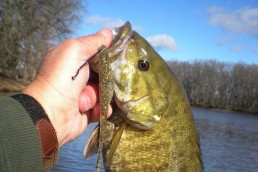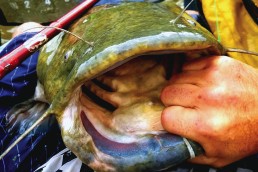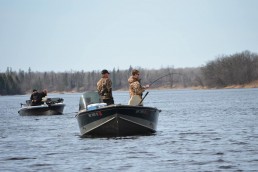SHARE THIS POST
It was a quiet summer night as the barely audible whir of the trolling motor pushed us toward the boat landing. A few quiet splashes apparently piqued the interest of my companion.
“Just stop here for a minute,” he whispered.
I stopped, and the soft “splat” indicated that his lure had hit the surface. The subtle gurgling sound identified his prop bait moving across the surface.
Suddenly, a much louder splash was heard and my friend’s subsequent grunt indicated that he had a fish on.
About 30 seconds later, he had lifted a 2-pound largemouth into the boat.
The surface noise continued, and I flicked my headlamp on and rooted around for a bait. I found a rather old twin prop Injured Minnow in the bottom drawer of my box.
Five minutes later, another largemouth didn’t really care that my Injured Minnow was an oldie but a goodie; the hooks still worked. We ended that night with half a dozen more bass before we made our way to the landing.
It’s a fact: big fish eat little fish, and mostly minnows. It can be a variety from little fatheads to larger shiners and suckers. And, if the minnows are old, wounded or weak, it’s even better because the pickings are easy.
As I’ve found out, it always pays to have minnow-type baits in your boat because those little minnows drive the food chain. And in today’s fish-catching tool world, there are a wide variety of baits that can be made to mimic the wounded minnows. They all catch fish. Sometimes, it just depends on how you or the fish want those minnows served.
Back in my youth, the Injured Minnow was used when we wanted to present a wounded baitfish imitation on the surface. And the bass loved it. I also found that it did a heck of a job on northern pike. The Original Rapala changed all that. Now, we had a bait that we could twitch on the surface. And if that didn’t get bit we could reel it back subsurface and turn it into a crankbait. Stopping and starting the retrieve was another way to draw a strike. We still do the “stop and start” today, but with newer technology we can now do this anywhere from subsurface down to 10, 15, and even 20 feet.
Are you enjoying this post?
You can be among the first to get the latest info on where to go, what to use and how to use it!
The materials and action for today’s lures continue to be improved so we have a plethora of baits that fit the “minnow” designation. And, you can make these all act like they’re wounded or dying, making it easy for an alert predator to invite itself to lunch.
You can imitate a minnow no matter how you fish. Hard jerkbaits—the original, long, minnow-shaped lures now—include Rapalas, Smithwick Rogues, Lucky Craft Pointers and others. Basically, some float or suspend so they can be jerked along underwater. These are great baits for early-season, coldwater fish, especially smallmouths. In the cold, just let them sit longer, as much as 30 seconds. In warmer weather like now in July, use a more active cadence with two pulls, a stop, and then a pull again. Rapala’s Shadow Rap Minnow is a very slow-sinking version that can almost be worked in place. This is a very slow-rising bait too, which gives you more options.
Soft jerkbaits are also part of today’s minnow explosion. The original stick worm, the Senko, is made to seductively sink with a slow, rocking motion to trigger fish. They are heavy enough to fish “unweighted” and still get down deep, while the Fluke-type minnow bait (most have a forked tail) can be fished weightless tight to shore or with a lighter weight at 1/16 ounce. If you’re fishing it along riprap or sloping banks, both can be rigged weedless to keep them from grabbing anything and getting snagged.
Swimbaits have also entered the picture, and you can go crazy on size in both the hard and soft plastic versions. Most swimbaits, however, are usually 4 to 6 inches and minnow-shaped soft plastics with boot tails that vibrate when you retrieve them to call in the fish. There are a good number of hooks for these baits on the market so you can match a hook with the bait size to give you the best hook-set. These call for up to 8/0 size, and then 1/2 ounce or heavier heads. These baits are bulky, so sometimes you want more weight just to help them get deeper. There are also lighter heads for shallower applications.
It pays to experiment with lure, hook and weight size based on where you want to fish these baits. I’d still call them minnow “imitations.” But if you fish down in the South and see the size of some of the shad there you can understand why there are many different lengths used.
When they first hit the water, a lot of anglers wondered exactly what the tubes were supposed to imitate. Since a tube is a jig, the logical choice was a crawfish. However, if you rig a tube with the head inside of the hollow body, you have to let it sink to the bottom then snap your rod tip up—a smoke and silver or a white/smoke and silver laminate body looks a whole lot like a minnow that’s injured or dying. These pop up off the bottom then spiral back down, which is a different action than rigging one Texas style with the weight on the outside front. Those seem to shoot ahead on the retrieve or crawl across the bottom. Again, you can make these baits act like a wounded minnow or a craw.
Even the old standard bass jig has gotten into the minnow act. Jigs were universally crawfish imitators at first, but as manufacturers developed models where the hook eye was coming out the front of the jig (a 30- to 60-degree angle), rather than the top (90-degree angle), it then made it easier to work the jig through cover. Now, anglers can swim them through weeds and tree limbs. And depending on the skirt’s color, they can now imitate a minnow, bluegill or craw.
While jerkbaits probably get a little more comparison to minnows than the other crankbaits, the regular crankbaits are also minnow imitations, just for a little deeper water. The spinnerbaits still catch their share of fish, and the willow leaf suggests a minnow-silver side flash while the Colorado blade offers some flash too along with more vibration that can be picked up by the lateral line. The Z-Man ChatterBait gets the nod for me, offering flash and vibration with some side-to-side motion as well.
When you look at today’s lure selections and improvements there are many factors to consider. But those minnow imitations still work and are now even better than ever. There are a lot of different types and many ways to fish them once you hit the water this summer.
MWO
SHARE THIS POST
Did you enjoy this post?
You can be among the first to get the latest info on where to go, what to use and how to use it!
Tom Luba
Tom Luba is a freelance outdoor writer living in New London, Wis. He has written about open water fishing for more than 35 years.



